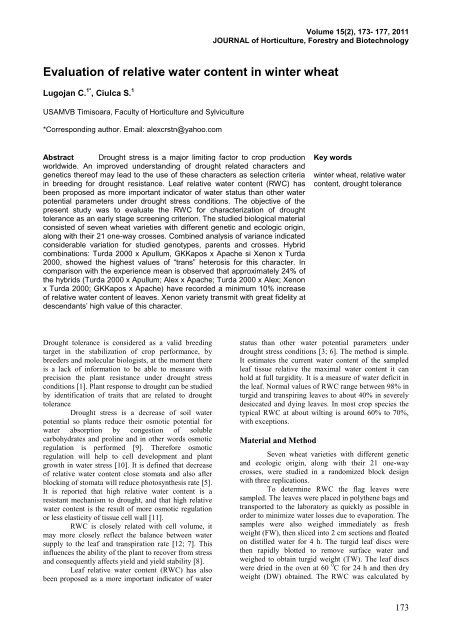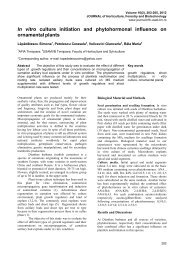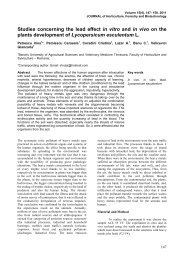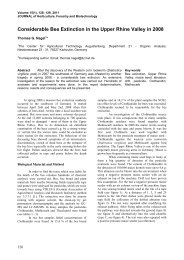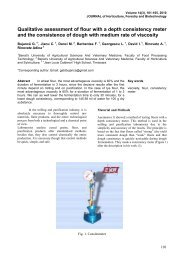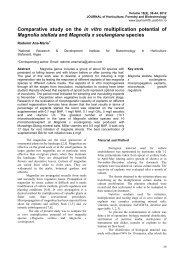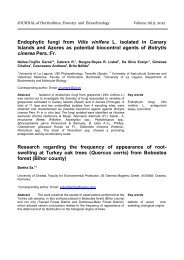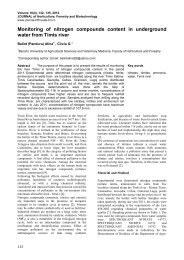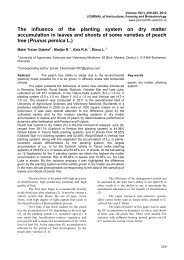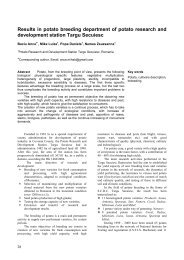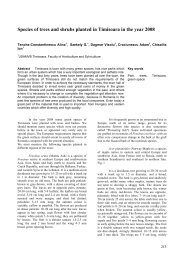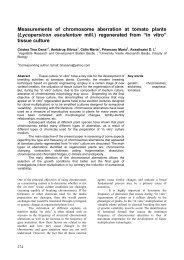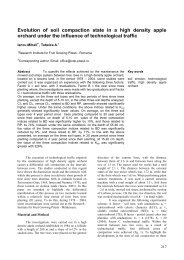Evaluation of relative water content in winter wheat - Journal of ...
Evaluation of relative water content in winter wheat - Journal of ...
Evaluation of relative water content in winter wheat - Journal of ...
Create successful ePaper yourself
Turn your PDF publications into a flip-book with our unique Google optimized e-Paper software.
Volume 15(2), 173- 177, 2011<br />
JOURNAL <strong>of</strong> Horticulture, Forestry and Biotechnology<br />
<strong>Evaluation</strong> <strong>of</strong> <strong>relative</strong> <strong>water</strong> <strong>content</strong> <strong>in</strong> w<strong>in</strong>ter <strong>wheat</strong><br />
Lugojan C. 1* , Ciulca S. 1<br />
USAMVB Timisoara, Faculty <strong>of</strong> Horticulture and Sylviculture<br />
*Correspond<strong>in</strong>g author. Email: alexcrstn@yahoo.com<br />
Abstract Drought stress is a major limit<strong>in</strong>g factor to crop production<br />
worldwide. An improved understand<strong>in</strong>g <strong>of</strong> drought related characters and<br />
genetics there<strong>of</strong> may lead to the use <strong>of</strong> these characters as selection criteria<br />
<strong>in</strong> breed<strong>in</strong>g for drought resistance. Leaf <strong>relative</strong> <strong>water</strong> <strong>content</strong> (RWC) has<br />
been proposed as more important <strong>in</strong>dicator <strong>of</strong> <strong>water</strong> status than other <strong>water</strong><br />
potential parameters under drought stress conditions. The objective <strong>of</strong> the<br />
present study was to evaluate the RWC for characterization <strong>of</strong> drought<br />
tolerance as an early stage screen<strong>in</strong>g criterion. The studied biological material<br />
consisted <strong>of</strong> seven <strong>wheat</strong> varieties with different genetic and ecologic orig<strong>in</strong>,<br />
along with their 21 one-way crosses. Comb<strong>in</strong>ed analysis <strong>of</strong> variance <strong>in</strong>dicated<br />
considerable variation for studied genotypes, parents and crosses. Hybrid<br />
comb<strong>in</strong>ations: Turda 2000 x Apullum, GKKapos x Apache si Xenon x Turda<br />
2000, showed the highest values <strong>of</strong> “trans” heterosis for this character. In<br />
comparison with the experience mean is observed that approximately 24% <strong>of</strong><br />
the hybrids (Turda 2000 x Apullum; Alex x Apache; Turda 2000 x Alex; Xenon<br />
x Turda 2000; GKKapos x Apache) have recorded a m<strong>in</strong>imum 10% <strong>in</strong>crease<br />
<strong>of</strong> <strong>relative</strong> <strong>water</strong> <strong>content</strong> <strong>of</strong> leaves. Xenon variety transmit with great fidelity at<br />
descendants’ high value <strong>of</strong> this character.<br />
Key words<br />
w<strong>in</strong>ter <strong>wheat</strong>, <strong>relative</strong> <strong>water</strong><br />
<strong>content</strong>, drought tolerance<br />
Drought tolerance is considered as a valid breed<strong>in</strong>g<br />
target <strong>in</strong> the stabilization <strong>of</strong> crop performance, by<br />
breeders and molecular biologists, at the moment there<br />
is a lack <strong>of</strong> <strong>in</strong>formation to be able to measure with<br />
precision the plant resistance under drought stress<br />
conditions [1]. Plant response to drought can be studied<br />
by identification <strong>of</strong> traits that are related to drought<br />
tolerance<br />
Drought stress is a decrease <strong>of</strong> soil <strong>water</strong><br />
potential so plants reduce their osmotic potential for<br />
<strong>water</strong> absorption by congestion <strong>of</strong> soluble<br />
carbohydrates and prol<strong>in</strong>e and <strong>in</strong> other words osmotic<br />
regulation is performed [9]. Therefore osmotic<br />
regulation will help to cell development and plant<br />
growth <strong>in</strong> <strong>water</strong> stress [10]. It is def<strong>in</strong>ed that decrease<br />
<strong>of</strong> <strong>relative</strong> <strong>water</strong> <strong>content</strong> close stomata and also after<br />
block<strong>in</strong>g <strong>of</strong> stomata will reduce photosynthesis rate [5].<br />
It is reported that high <strong>relative</strong> <strong>water</strong> <strong>content</strong> is a<br />
resistant mechanism to drought, and that high <strong>relative</strong><br />
<strong>water</strong> <strong>content</strong> is the result <strong>of</strong> more osmotic regulation<br />
or less elasticity <strong>of</strong> tissue cell wall [11].<br />
RWC is closely related with cell volume, it<br />
may more closely reflect the balance between <strong>water</strong><br />
supply to the leaf and transpiration rate [12; 7]. This<br />
<strong>in</strong>fluences the ability <strong>of</strong> the plant to recover from stress<br />
and consequently affects yield and yield stability [8].<br />
Leaf <strong>relative</strong> <strong>water</strong> <strong>content</strong> (RWC) has also<br />
been proposed as a more important <strong>in</strong>dicator <strong>of</strong> <strong>water</strong><br />
status than other <strong>water</strong> potential parameters under<br />
drought stress conditions [3; 6]. The method is simple.<br />
It estimates the current <strong>water</strong> <strong>content</strong> <strong>of</strong> the sampled<br />
leaf tissue <strong>relative</strong> the maximal <strong>water</strong> <strong>content</strong> it can<br />
hold at full turgidity. It is a measure <strong>of</strong> <strong>water</strong> deficit <strong>in</strong><br />
the leaf. Normal values <strong>of</strong> RWC range between 98% <strong>in</strong><br />
turgid and transpir<strong>in</strong>g leaves to about 40% <strong>in</strong> severely<br />
desiccated and dy<strong>in</strong>g leaves. In most crop species the<br />
typical RWC at about wilt<strong>in</strong>g is around 60% to 70%,<br />
with exceptions.<br />
Material and Method<br />
Seven <strong>wheat</strong> varieties with different genetic<br />
and ecologic orig<strong>in</strong>, along with their 21 one-way<br />
crosses, were studied <strong>in</strong> a randomized block design<br />
with three replications.<br />
To determ<strong>in</strong>e RWC the flag leaves were<br />
sampled. The leaves were placed <strong>in</strong> polythene bags and<br />
transported to the laboratory as quickly as possible <strong>in</strong><br />
order to m<strong>in</strong>imize <strong>water</strong> losses due to evaporation. The<br />
samples were also weighed immediately as fresh<br />
weight (FW), then sliced <strong>in</strong>to 2 cm sections and floated<br />
on distilled <strong>water</strong> for 4 h. The turgid leaf discs were<br />
then rapidly blotted to remove surface <strong>water</strong> and<br />
weighed to obta<strong>in</strong> turgid weight (TW). The leaf discs<br />
were dried <strong>in</strong> the oven at 60 0 C for 24 h and then dry<br />
weight (DW) obta<strong>in</strong>ed. The RWC was calculated by<br />
173
the formula given by Barrs (1968): RWC (%) = [FW-<br />
DW)/(TW-DW] * 100<br />
The determ<strong>in</strong>ation <strong>of</strong> differences significance<br />
between the studied cultivars and crosses, the<br />
process<strong>in</strong>g <strong>of</strong> obta<strong>in</strong>ed experimental data was<br />
performed us<strong>in</strong>g variance analysis and t test accord<strong>in</strong>g<br />
to Ciulca, 2006.<br />
Results and Discussions<br />
In terms <strong>of</strong> <strong>relative</strong> <strong>water</strong> <strong>content</strong> <strong>of</strong> leaves for<br />
F 1 hybrids (table 1), 38% <strong>of</strong> the hybrids were superior<br />
to both parents and approximately 24% were <strong>in</strong>ferior to<br />
both parental forms. Among the crosses <strong>in</strong>termediate to<br />
the parental forms, about 24 % have achieved higher<br />
values <strong>of</strong> this trait, and 14% lower values compar<strong>in</strong>g to<br />
mid parent. Compared with the parents mean the<br />
crosses <strong>of</strong> this generation showed an amplitude <strong>of</strong><br />
43.47%, while the average values <strong>of</strong> "cis" heterosis<br />
were very low (1.27%) and the "trans" heterosis were<br />
6.54%. Hybrid comb<strong>in</strong>ations: Turda 2000 x Apullum,<br />
GKKapos x Apache si Xenon x Turda 2000, showed<br />
the highest values <strong>of</strong> “trans” heterosis for this<br />
character.<br />
Table 1<br />
Express manner <strong>of</strong> the leaf <strong>relative</strong> <strong>water</strong> <strong>content</strong> <strong>in</strong> F 1 hybrids<br />
Number Number and proportion (%) <strong>of</strong> F 1 hybrids Range to Mean<br />
<strong>of</strong> studied Superior to Intermediary between parents Inferior to parents mean (%) Heterosis (%)<br />
hybrids parents Above the Below the parents “cis” “trans”<br />
mean mean<br />
21 8 (38.09%) 5 (23.81%) 3 (14.29 %) 5 (23.81%) 74.81 – 118.28 101.27 106.54<br />
The highest values <strong>of</strong> heterosis <strong>in</strong>dex have<br />
achieved by the hybrids GKKapos x Turda 2000<br />
(18.50), Fundulea 4 x Apache (3.76), comb<strong>in</strong>ations <strong>in</strong><br />
which there were no significant differences between<br />
the parental forms <strong>in</strong> terms <strong>of</strong> this character. The<br />
lowest values <strong>of</strong> heterosis <strong>in</strong>dex, correlated with low<br />
<strong>water</strong> retention capacity, were registered <strong>in</strong> hybrids:<br />
Alex x Apullum (-2.58), GKKapos x Apullum (-1.60),<br />
GKKapos x Alex (-1.48).<br />
Heterosis <strong>in</strong>dex for leaf <strong>relative</strong> <strong>water</strong> <strong>content</strong> <strong>in</strong> F 1 hybrids<br />
Genitors Fundulea 4 Xenon GKKapos Turda 2000 Alex Apache Apullum<br />
Fundulea 4 - 0.54 0.14 -1.26 0.14 3.76 -0.90<br />
Xenon - -0.29 1.98 -0.20 0.01 -0.38<br />
GKKapos - 18.50 -1.48 1.36 -1.60<br />
Turda 2000 - 0.41 0.64 1.18<br />
Alex - 0.51 -2.58<br />
Apache - 0.30<br />
Apullum -<br />
Table 2<br />
Variance analysis presented <strong>in</strong> table 3a shows that<br />
there are real differences between the studied hybrid<br />
comb<strong>in</strong>ations <strong>in</strong> terms <strong>of</strong> <strong>relative</strong> <strong>water</strong> <strong>content</strong> <strong>of</strong><br />
leaves. Reduced heterogeneity <strong>of</strong> experimental<br />
conditions between repetition does not significantly<br />
<strong>in</strong>fluence the results <strong>of</strong> measurements for this character<br />
at studied hybrid comb<strong>in</strong>ations.<br />
a) Variance analysis <strong>of</strong> leaf <strong>relative</strong> <strong>water</strong> <strong>content</strong> <strong>in</strong> F 1 hybrids<br />
Variability source SS DF MS F Test<br />
Total 6443.04 65<br />
Repetitions 188.78 2 94.39 F = 2.51<br />
Hybrids 4677.48 21 222.74 F = 5.93**<br />
Erorr 1576.78 42 37.54<br />
Table 3<br />
174
) Estimative values and the significance <strong>of</strong> differences between F 1 hybrids concern<strong>in</strong>g<br />
leaf <strong>relative</strong> <strong>water</strong> <strong>content</strong><br />
No. Hybrids RWC (%) Relative Difference/<br />
x s<br />
x s % value (%) Signifficance<br />
1 Hybrids Mean 70.38+1.20 2.94 100.00 Control<br />
2 Fundulea 4 x Xenon 74.23+6.42 14.98 105.48 3.86<br />
3 Fundulea 4 x GKKapos 65.40+2.14 5.66 92.93 -4.98<br />
4 Fundulea 4 x Turda 2000 48.50+2.53 9.04 68.91 -21.88 000<br />
5 Fundulea 4 x Alex 71.32+2.22 5.39 101.33 0.94<br />
6 Fundulea 4 x Apache 71.08+0.94 2.29 100.99 0.70<br />
7 Fundulea 4 x Apullum 50.28+1.58 5.44 71.44 -20.10 000<br />
8 Xenon x GKKapos 70.51+2.22 5.45 100.18 0.13<br />
9 Xenon x Turda 2000 79.15+1.45 3.17 112.46 8.77<br />
10 Xenon x Alex 75.23+3.66 8.42 106.89 4.85<br />
11 Xenon x Apache 67.38+6.46 16.61 95.74 -3.00<br />
12 Xenon x Apullum 74.09+8.54 19.97 105.27 3.71<br />
13 GKKapos x Turda 2000 76.11+0.89 2.03 108.14 5.73<br />
14 GKKapos x Alex 60.54+5.47 15.64 86.03 -9.83<br />
15 GKKapos x Apache 77.21+1.53 3.44 109.70 6.83<br />
16 GKKapos x Apullum 61.95+4.69 13.11 88.02 -8.43<br />
17 Turda2000 x Alex 78.12+1.22 2.71 111.00 7.74<br />
18 Turda2000 x Apache 71.22+2.21 5.37 101.20 0.85<br />
19 Turda2000 x Apullum 81.13+0.55 1.18 115.28 10.75*<br />
20 Alex x Apache 79.12+3.64 7.96 112.43 8.75<br />
21 Alex x Apullum 71.86+3.99 9.61 102.11 1.48<br />
22 Apache x Apullum 73.53+2.53 5.95 104.48 3.16<br />
LSD 5% = 10.09 LSD 1% = 13.49 LSD 0,1% = 17.70<br />
The studied hybrids have recorded values <strong>of</strong> this<br />
character rang<strong>in</strong>g from 48.50 % <strong>in</strong> Fundulea 4 x Turda<br />
2000 to 81.13 % for Turda2000 x Apullum, with<br />
variation amplitude <strong>of</strong> 32.63%, aga<strong>in</strong>st a low <strong>in</strong>tergenotypic<br />
variability. Intra-genotypic variability was<br />
generally low for most comb<strong>in</strong>ations except hybrids:<br />
Xenon x Apullum, Xenon x Apache, GKKapos x Alex,<br />
Fundulea 4 x Xenon si GKKapos x Apullum, where a<br />
medium variability was observed.<br />
In comparison with the experience mean is<br />
observed that approximately 24% <strong>of</strong> the hybrids (Turda<br />
2000 x Apullum; Alex x Apache; Turda 2000 x Alex;<br />
Xenon x Turda 2000; GKKapos x Apache) have<br />
recorded a m<strong>in</strong>imum 10% <strong>in</strong>crease <strong>of</strong> <strong>relative</strong> <strong>water</strong><br />
<strong>content</strong> <strong>of</strong> leaves, but only for the comb<strong>in</strong>ation Turda<br />
2000 x Apullum the <strong>in</strong>creases were statistically<br />
assured. Because the <strong>water</strong> retention capacity <strong>of</strong> these<br />
genotypes is <strong>in</strong>creased, the yield could be <strong>in</strong>creased or<br />
at least stabilized.<br />
A low drought tolerance associated with<br />
values <strong>of</strong> <strong>relative</strong> <strong>water</strong> <strong>content</strong> <strong>of</strong> leaves significantly<br />
below the mean were observed <strong>in</strong> the case <strong>of</strong> hybrids:<br />
Fundulea 4 x Turda 2000, Fundulea 4 x Apullum. As<br />
such, <strong>in</strong> the case <strong>of</strong> these comb<strong>in</strong>ations the variety<br />
Fundulea 4 show a high general comb<strong>in</strong><strong>in</strong>g ability to<br />
transmit to <strong>of</strong>fspr<strong>in</strong>g low values <strong>of</strong> <strong>relative</strong> <strong>water</strong><br />
<strong>content</strong> <strong>of</strong> leaves.<br />
The significance <strong>of</strong> differences between groups <strong>of</strong> F 1 hybrids with the same recurrent parent<br />
concern<strong>in</strong>g leaf <strong>relative</strong> <strong>water</strong> <strong>content</strong><br />
No. Reccurent Fundulea 4 Xenon GKKapos Turda 2000 Alex Apache Apullum<br />
parent F 1 Mean 63.47 73.43 68.62 72.37 72.70 73.26 68.80<br />
1 Fundulea 4 63.47 -9.96 -5.15 -8.90 -9.23 -9.79 -5.33<br />
2 Xenon 73.43 4.81 1.06 0.73 0.17 4.63<br />
3 GKKapos 68.62 -3.75 -4.08 -4.64 -0.18<br />
4 Turda 2000 72.37 -0.33 -0.88 3.58<br />
5 Alex 72.70 -0.56 3.90<br />
6 Apache 73.26 4.46<br />
7 Apullum 68.80<br />
Table 4<br />
LSD 5% LSD 1% LSD 0,1 %<br />
10.17 13.65 17.99<br />
175
RWC (%)<br />
Tak<strong>in</strong>g <strong>in</strong>to account the groups <strong>of</strong> hybrids with the<br />
same recurrent parent is observed that the highest <strong>water</strong><br />
retention capacity shows the hybrids <strong>of</strong> varieties:<br />
Xenon and Apache, while the hybrids <strong>of</strong> variety<br />
Fundulea 4 exhibit a low <strong>water</strong> retention potential <strong>in</strong><br />
the leaves. The differences observed between the<br />
groups <strong>of</strong> hybrids <strong>of</strong> the different varieties, have not<br />
reached the level <strong>of</strong> statistical assurance.<br />
80<br />
75<br />
70<br />
65<br />
60<br />
55<br />
50<br />
Fundulea 4 Xenon GKKapos Turda 2000 Alex Apache Apullum<br />
F1 63.47 73.43 68.62 72.37 72.7 73.26 68.8<br />
P 57.78 73.68 69.65 69.99 78.94 60.9 76.64<br />
Fig .1. Leaf <strong>relative</strong> <strong>water</strong> <strong>content</strong> for groups <strong>of</strong> F 1 hybrids with the same recurrent parent<br />
In comparison with the recurrent parent, the<br />
hybrids <strong>of</strong> varieties Apache and Fundulea 4 showed a<br />
significantly higher value <strong>of</strong> <strong>relative</strong> <strong>water</strong> <strong>content</strong> <strong>of</strong><br />
leaves. The hybrids <strong>of</strong> Xenon variety did not show<br />
differences from the recurrent parent, suggest<strong>in</strong>g that<br />
this variety transmit with great fidelity at descendants’<br />
high value <strong>of</strong> this character.<br />
At the hybrids <strong>of</strong> the varieties which showed<br />
high values <strong>of</strong> this character, such as Apullum, Alex<br />
GKKapos, is observed a decrease <strong>of</strong> <strong>relative</strong> <strong>water</strong><br />
<strong>content</strong> <strong>of</strong> leaves on a background <strong>of</strong> low comb<strong>in</strong>ative<br />
abilities <strong>of</strong> those parental forms.<br />
Conclusions<br />
Comb<strong>in</strong>ed analysis <strong>of</strong> variance <strong>in</strong>dicated<br />
considerable variation for studied genotypes,<br />
parents and crosses. Hybrid comb<strong>in</strong>ations: Turda<br />
2000 x Apullum, GKKapos x Apache si Xenon x<br />
Turda 2000, showed the highest values <strong>of</strong> “trans”<br />
heterosis for this character.<br />
In comparison with the experience mean is<br />
observed that approximately 24% <strong>of</strong> the hybrids<br />
(Turda 2000 x Apullum; Alex x Apache; Turda<br />
2000 x Alex; Xenon x Turda 2000; GKKapos x<br />
Apache) have recorded a m<strong>in</strong>imum 10% <strong>in</strong>crease <strong>of</strong><br />
<strong>relative</strong> <strong>water</strong> <strong>content</strong> <strong>of</strong> leaves, but only for the<br />
comb<strong>in</strong>ation Turda 2000 x Apullum the <strong>in</strong>creases<br />
were statistically assured. Because the <strong>water</strong><br />
retention capacity <strong>of</strong> these genotypes is <strong>in</strong>creased,<br />
the yield could be <strong>in</strong>creased or at least stabilized.<br />
References<br />
1. Blum, A. 1996. Crop response to drought and the<br />
<strong>in</strong>tepretation <strong>of</strong> adaptation. Plant Growth Regulation,<br />
20: 135-148.<br />
2. Barrs, H.D., 1968. Determ<strong>in</strong>ation <strong>of</strong> <strong>water</strong> deficits <strong>in</strong><br />
plant tissues. In: T.T. Kozolvski (Ed.),Water Deficits<br />
and Plant Growth, Vol 1, pp 235–368. Academic<br />
Press, New Delhi.<br />
3. Carter Jr., T.E., R.P. Patterson, 1985. Use <strong>of</strong> <strong>relative</strong><br />
<strong>water</strong> <strong>content</strong> as a selection tool for drought tolerance<br />
<strong>in</strong> soybean. Fide Agron abstr 77th Annu Meet<strong>in</strong>g, p 77.<br />
4. Ciulca S. 2006. Metodologii de experimentare <strong>in</strong><br />
agricultura si biologie. Ed Agropr<strong>in</strong>t, Timisoara.<br />
5. Cornic, G., 2000. Drought stress <strong>in</strong>hibits<br />
photosynthesis by decreas<strong>in</strong>g stomatal aperture–not by<br />
affect<strong>in</strong>g ATP synthesis. Trends <strong>in</strong> Plant Science 5 (5),<br />
187–188.<br />
6. Dhanda S.S., G.S. Sethi 2002. Tolerance to drought<br />
stress among selected Indian <strong>wheat</strong> cultivars<br />
7. Farquhar, G.D., S.C. Wong, J.R. Evans, K.T. Hubic,<br />
1989. Photosynthesis and gas exchange. In: H.G.<br />
Jones, T.J. Flowers & M.B. Jones (Eds.), Plant under<br />
Stress, pp 47–69. Cambridge University Press,<br />
Cambridge.<br />
176
8.Lilley, J.M., M.M. Ludlow, 1996. Expression <strong>of</strong><br />
osmotic adjustment and dehydration tolerance <strong>in</strong><br />
diverse rice l<strong>in</strong>es. Field Crop Res 48: 185–197.<br />
9. Mart<strong>in</strong>, M., F. Micell, J.A.Morgan, M.Scalet,<br />
G.Zerbi .1993.synthesis <strong>of</strong> osmotically active<br />
substances <strong>in</strong> w<strong>in</strong>ter heat leaves as related to drought<br />
resistance <strong>of</strong> different genotypes. J. <strong>of</strong> Agronorny and<br />
crop science. 171:176-184.<br />
10. Pessarkli, M.1999. Hand book <strong>of</strong> plant and crop<br />
stress. Marcel Dekker Inc. 697 p.<br />
11. Ritchie,S.W.,Nguyan ,H.T., Holaday. A.S.1990.<br />
Leaf Water <strong>content</strong> and gas exchange parameters <strong>of</strong><br />
two <strong>wheat</strong> genotypes differ<strong>in</strong>g <strong>in</strong> drought resistance.<br />
Crop sci.30:105-111.<br />
12. Schonfeld, M.A., R.C. Johnson, B.F. Carver, D.W.<br />
Mornhigweg, 1988. Water relations <strong>in</strong> w<strong>in</strong>ter <strong>wheat</strong> as<br />
drought resistance <strong>in</strong>dicators. Crop Sci 28: 526–531.<br />
177


